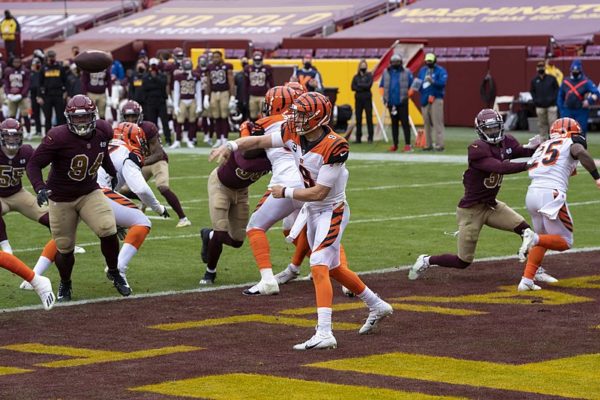If you’re enough of a degen to seek fantasy football advice in the middle of May, then you’ve surely heard the hype surrounding rookies from dynasty leaguers and even people drafting in best ball leagues, like the popular MFL10.
Fantasy analysts are justified in their excitement about these first year prospects in their respective league formats, but that enthusiasm inevitably creeps into the minds of redrafters early in the summer and carries on into August. When it comes to rookie wide receivers, especially, this optimism usually equates to lost value on draft day.
The problem with rookie wide receivers isn’t that they won’t have big games; they will. Rookie hype usually leads to overinflated draft prices, though, and finding any type of consistent production from rookie wide receivers is very rare.
Startable Games
In an Apex league, a startable game from a wide receiver means that they finished a week as the WR36 or better (12 teams, 3 WR spots). Over the last five seasons, rookies have accounted for just 9% of all such games in PPR leagues.
| Season | Rookie WR Startable Games |
|---|---|
| 2009 | 59 |
| 2010 | 45 |
| 2011 | 49 |
| 2012 | 47 |
| 2013 | 48 |
Since 2009, all rookie receivers combined amassed just 248 startable games. For perspective, over a 5 year period there are 2700* startable games to be had from the wide receiver position. Of those 248 startable games, many came from rookies that were not targeted by redrafters. For the most part, fantasy owners tendencies, regarding drafting of rookies, will mirror the real draft, meaning only early round picks are likely to be drafted by fake footballers.
*Assuming most leagues end week 16, 36 startable games/week X 15 weeks X 5 seasons = 2700
Fantasy Draft Day Targets
For draft value purposes, we want to explore how rookie wide receivers that actually make it onto fantasy rosters in August fare in terms of fantasy production. Going into a redraft, owners will almost exclusively look for rookie wide receivers that were drafted in the first two rounds, as those are the rookies that are most likely to see playing time in their first season.
From 2009-2013, 35 receivers were drafted in the first two rounds. Between those 35 rookies, they produced 109 startable weeks, meaning that almost 60% of top 36 fantasy games from rookie wide receivers came from players drafted outside of the first two rounds, or players who likely weren’t drafted in redraft leagues.
Here’s a breakdown of total startable gamess by draft round:
UD = Undrafted
A quick glance at this chart might prompt someone to assume that at least first round wide receivers are reasonable investments. On the whole, first rounders have turned in startable gamess 26% of the time, which doesn’t seem too bad. The owner’s conundrum, though, is figuring out when those decent weeks will come, an issue of player consistency.
Startable Game Consistency
As illustrated in the startable games graph, likely fantasy redraft targets (1st and 2nd round picks) accounted for 109 startable games over the last 5 years, but that doesn’t tell us how many rookies provided owners with reliable production. Using startable games as a measuring stick, we can call receivers with 6 or more top 36 games consistent options. In 2013, 22 receivers finished as fantasy starters over a third of the time, and in 2012 the number was 25. Since 2009, just 11 rookies wide receivers have had what we would considered a consistent fantasy season.
| Player | Season | Startable Games | Draft Round |
|---|---|---|---|
| A.J. Green | 2011 | 10 | 1 |
| Hakeem Nicks | 2009 | 7 | 1 |
| Percy Harvin | 2009 | 7 | 1 |
| Kenny Britt | 2009 | 6 | 1 |
| Julio Jones | 2011 | 6 | 1 |
| Torrey Smith | 2011 | 6 | 2 |
| Keenan Allen | 2013 | 8 | 3 |
| T.Y. Hilton | 2012 | 6 | 3 |
| Terrance Willilams | 2013 | 6 | 3 |
| Mike Williams | 2010 | 10 | 4 |
| Austin Collie | 2009 | 8 | 4 |
Of all rookies to turn in a consistent year, just over half were drafted in the first two rounds. Recall that over the last five seasons, 35 receivers were taken in the first two rounds, and recent history suggests that roughly 17% of possible rookie redraft targets, or about 1 per season, will be a reliable source of fantasy output.
Conclusion
Drafting in fantasy football always comes down to maximizing value. In terms of rookie wide receivers, the value that is tied to their potential upside is negated when these rookies start moving up draft boards into the middle rounds. Rookies have a very wide range of outcomes, regardless of their situation, and drafting any player at their ceiling goes against all wise investing strategies. While other owners reach for inconsistent and unpredictable rookies, they are leaving value on the table for savvy owners that avoid the unnecessary risk.


